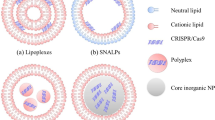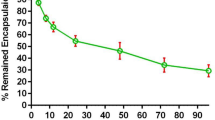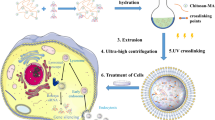Abstract
Cationic liposomes have been successfully used as an alternative approach to viral systems to deliver nucleic acids. However, high toxicity and inconsistent transfection efficiency have been associated with the currently available liposomes. Therefore, a novel cationic liposome was developed based on a synthetic cationic cardiolipin analogue (CCLA) to test the DNA transfection efficiency. This CCLA-based liposome was also used to determine the therapeutic efficacy of c-raf small interfering RNA (siRNA) in mice. In this report, we showed that the CCLA-based liposome was less toxic and effectively transfected reporter genes in vitro and in vivo. The transfection efficiency in mice was seven-fold higher than the commercially available DOTAP-based liposome. In addition, c-raf siRNA in the presence of CCLA-based liposome induced up to 62% of growth inhibition in cancer cells. Treatment of c-raf siRNA/CCLA complex in SCID mice bearing human breast xenograft tumors resulted in 73% of tumor growth suppression as compared to free c-raf siRNA group. In conclusion, a novel CCLA-based liposome showed less toxicity and broad usage both in vitro and in vivo with DNA and siRNA.
This is a preview of subscription content, access via your institution
Access options
Subscribe to this journal
Receive 12 print issues and online access
$259.00 per year
only $21.58 per issue
Buy this article
- Purchase on Springer Link
- Instant access to full article PDF
Prices may be subject to local taxes which are calculated during checkout





Similar content being viewed by others
Abbreviations
- CCLA:
-
cationic cardiolipin analogue
- siRNA:
-
small interfering RNA
- DOTAP:
-
1,2,-dioleoyl-3-trimethylammoniumpropane
- DOTMA:
-
1,2-dioleyloxypropyl-3-trimethylammonium chloride
- DOSPA:
-
2,3-dioleoyloxy-N-[2- (spermine-carboxamido)ethyl]-N,N-dimethyl-1-propanaminium
- DOPE:
-
dioleoylphosphatidylethanolamine
- DOPC:
-
dioleoylphosphatidylcholine
- HI-FBS:
-
heat-inactivated fetal bovine serum
- SRB:
-
sulforhodamine B
- β-gal:
-
β-galactosidase
- iv:
-
intravenous
References
Felgner PL, Gadek TR, Holm M, et al. Lipofection: a highly efficient, lipid-mediated DNA-transfection procedure. Proc Natl Acad Sci USA. 1987;84:7413–7417.
Audouy SA, de Leij LF, Hoekstra D, Molema G . In vivo characteristics of cationic liposomes as delivery vectors for gene therapy. Pharm Res. 2002;19:1599–1605.
Pedroso de Lima MC, Neves S, Filipe A, Duzgunes N, Simoes S . Cationic liposomes for gene delivery: from biophysics to biological applications. Curr Med Chem. 2003;10:1221–1231.
Barron LG, Uyechi LS, Szoka Jr FC . Cationic lipids are essential for gene delivery mediated by intravenous administration of lipoplexes. Gene Ther. 1999;6:1179–1183.
Barron LG, Gagne L, Szoka Jr FC . Lipoplex-mediated gene delivery to the lung occurs within 60 minutes of intravenous administration. Hum Gene Ther. 1999;10:1683–1694.
Krasnici S, Werner A, Eichhorn ME, et al. Effect of the surface charge of liposomes on their uptake by angiogenic tumor vessels. Int J Cancer. 2003;105:561–567.
Uchida E, Mizuguchi H, Ishii-Watabe A, Hayakawa T . Comparison of the efficiency and safety of non-viral vector-mediated gene transfer into a wide range of human cells. Biol Pharm Bull. 2002;25:891–897.
Loisel S, Floch V, Le Gall C, Ferec C . Factors influencing the efficiency of lipoplexes mediated gene transfer in lung after intravenous administration. J Liposome Res. 2001;11:127–138.
Eliyahu H, Servel N, Domb AJ, Barenholz Y . Lipoplex-induced hemagglutination: potential involvement in intravenous gene delivery. Gene Ther. 2002;9:850–858.
Loisel S, Le Gall C, Doucet L, Ferec C, Floch V . Contribution of plasmid DNA to hepatotoxicity after systemic administration of lipoplexes. Hum Gene Ther. 2001;12:685–696.
Tousignant JD, Gates AL, Ingram LK, et al. Comprehensive analysis of the acute toxicities induced by systemic administration of cationic lipid:plasmid DNA complexes in mice. Hum Gene Ther. 2000;11:2493–2513.
Zou Y, Zong G, Ling YH, Perez-Soler R . Development of cationic liposome formulations for intratracheal gene therapy of early lung cancer. Cancer Gene Ther. 2000;7:683–696.
Stopeck AT, Jones A, Hersh EM, et al. Phase II study of direct intralesional gene transfer of allovectin-7, an HLA-B7/beta2-microglobulin DNA–liposome complex, in patients with metastatic melanoma. Clin Cancer Res. 2001;7:2285–2291.
Noone PG, Hohneker KW, Zhou Z, et al. Safety and biological efficacy of a lipid–CFTR complex for gene transfer in the nasal epithelium of adult patients with cystic fibrosis. Mol Ther. 2000;1:105–114.
Hatch GM . Cardiolipin: biosynthesis, remodeling and trafficking in the heart and mammalian cells. Int J Mol Med. 1998;1:33–41.
Song YK, Liu F, Chu S, Liu D . Characterization of cationic liposome-mediated gene transfer in vivo by intravenous administration. Hum Gene Ther. 1997;8:1585–1594.
Gaucheron J, Wong T, Wong KF, Maurer N, Cullis PR . Synthesis and properties of novel tetraalkyl cationic lipids. Bioconjug Chem. 2002;13:671–675.
Kasireddy K, Ahmad MU, Ali SM, Ahmad I . Synthesis of novel cationic cardiolipin analogues for the optimal delivery of therapeutic agents. Tetrahedron Lett. 2004;45:2743–2746.
Caplen NJ, Mousses S . Short interfering RNA (siRNA)-mediated RNA interference (RNAi) in human cells. Ann NY Acad Sci. 2003;1002:56–62.
Woessmann W, Damm-Welk C, Fuchs U, Borkhardt A . RNA interference: new mechanisms for targeted treatment? Rev Clin Exp Hematol. 2003;7:270–291.
Lei S, Chien PY, Sheikh S, Zhang A, Ali S, Ahmad I . Enhanced therapeutic efficacy of a novel liposome-based formulation of SN-38 against human tumor models in SCID mice. Anticancer Drugs. 2004;15:773–778.
Skehan P, Storeng R, Scudiero D, et al. New colorimetric cytotoxicity assay for anticancer-drug screening. J Natl Cancer Inst. 1990;82:1107–1112.
Wang J, Guo X, Xu Y, Barron L, Szoka Jr FC . Synthesis and characterization of long chain alkyl acyl carnitine esters. Potentially biodegradable cationic lipids for use in gene delivery. J Med Chem. 1998;41:2207–2215.
Almofti MR, Harashima H, Shinohara Y, Almofti A, Baba Y, Kiwada H . Cationic liposome-mediated gene delivery: biophysical study and mechanism of internalization. Arch Biochem Biophys. 2003;410:246–253.
Felgner JH, Kumar R, Sridhar CN, et al. Enhanced gene delivery and mechanism studies with a novel series of cationic lipid formulations. J Biol Chem. 1994;269:2550–2561.
Sakurai F, Nishioka T, Yamashita F, Takakura Y, Hashida M . Effects of erythrocytes and serum proteins on lung accumulation of lipoplexes containing cholesterol or DOPE as a helper lipid in the single-pass rat lung perfusion system. Eur J Pharm Biopharm. 2001;52:165–172.
McLean JW, Fox EA, Baluk P, et al. Organ-specific endothelial cell uptake of cationic liposome–DNA complexes in mice. Am J Physiol. 1997;273:H387–H404.
Anwer K, Kao G, Proctor B, Rolland A, Sullivan S . Optimization of cationic lipid/DNA complexes for systemic gene transfer to tumor lesions. J Drug Target. 2000;8:125–135.
Hofland HE, Shephard L, Sullivan SM . Formation of stable cationic lipid/DNA complexes for gene transfer. Proc Natl Acad Sci USA. 1996;93:7305–7309.
Kolch W . Meaningful relationships: the regulation of the Ras/raf/MEK/ERK pathway by protein interaction. Biochem J. 2000;351:289–305.
Storm SM, Brennscheidt U, Sithanandam G, Rapp UR . Raf oncogenes in carcinogenesis. Crit Rev Oncogen. 1990;2:1–8.
Monia BP, Sasmor H, Johnston JF, et al. Sequence-specific antitumor activity of a phosphorothioate oligodeoxyribonucleotide targeted to human C-raf kinase supports an antisense mechanism of action in vivo. Proc Natl Acad Sci USA. 1996;93:15481–15484.
Mewani RR, Tang W, Rahman A, et al. Enhanced therapeutic effects of doxorubicin and paclitaxel in combination with liposome-entrapped ends-modified raf antisense oligonucleotide against human prostate, lung and breast tumor models. Int J Oncol. 2004;24:1181–1188.
Author information
Authors and Affiliations
Corresponding author
Rights and permissions
About this article
Cite this article
Chien, PY., Wang, J., Carbonaro, D. et al. Novel cationic cardiolipin analogue-based liposome for efficient DNA and small interfering RNA delivery in vitro and in vivo. Cancer Gene Ther 12, 321–328 (2005). https://doi.org/10.1038/sj.cgt.7700793
Received:
Published:
Issue Date:
DOI: https://doi.org/10.1038/sj.cgt.7700793
Keywords
This article is cited by
-
Transgene expression in mice of the Opa1 mitochondrial transmembrane protein through bicontinuous cubic lipoplexes containing gemini imidazolium surfactants
Journal of Nanobiotechnology (2021)
-
Fundamentals of siRNA and miRNA therapeutics and a review of targeted nanoparticle delivery systems in breast cancer
Biophysical Reviews (2018)
-
Therapeutic potential of siRNA and DNAzymes in cancer
Tumor Biology (2014)
-
Systemic delivery of E6/7 siRNA using novel lipidic particles and its application with cisplatin in cervical cancer mouse models
Gene Therapy (2011)
-
Anti-tumor effect of 125I-UdR in combination with Egr-1 promoter-based IFNγ gene therapy in vivo
Radiation and Environmental Biophysics (2010)



